Predictions Based on Different Climate Change Scenarios: The Habitat of Typical Locust Species Is Shrinking in Kazakhstan and Xinjiang, China
Abstract
Simple Summary
Abstract
1. Introduction
2. Materials and Methods
2.1. Species Occurrence Data
2.2. Environmental Variables
2.3. Modeling Process
2.4. Model Evaluation
3. Results
3.1. Model Evaluation and Contribution of Variables
3.2. Habitat Suitability under Current Conditions
3.3. Habitat Suitability under Future Conditions
4. Discussion
4.1. Influence of Environmental Factors on the Potential Distribution of Typical Locusts
4.2. Changes in the Geographic Distribution of Typical Locusts under Climate Change
4.3. Uncertainty and Outlook
5. Conclusions
Supplementary Materials
Author Contributions
Funding
Data Availability Statement
Acknowledgments
Conflicts of Interest
References
- Zhang, L.; Lecoq, M.; Latchininsky, A.; Hunter, D. Locust and Grasshopper Management. Annu. Rev. Entomol. 2019, 64, 15–34. [Google Scholar] [CrossRef] [PubMed]
- Latchininsky, A.V. Grasshopper Outbreak Challenges Conservation Status of a Small Hawaiian Island. Insect Conserv. Isl. 2008, 12, 149–163. [Google Scholar] [CrossRef]
- Gall, M.L.; Overson, R.; Cease, A. A Global Review on Locusts (Orthoptera: Acrididae) and Their Interactions with Livestock Grazing Practices. Front. Ecol. Evol. 2019, 7, 263. [Google Scholar] [CrossRef]
- Latchininsky, A.V. Locusts and Remote Sensing: A Review. JARS 2013, 7, 075099. [Google Scholar] [CrossRef]
- Chen, B.; Zou, H.; Zhang, B.; Zhang, X.; Jin, X.; Wang, C.; Zhang, X. Distribution Pattern and Change Prediction of Saposhnikovia Divaricata Suitable Area in China under Climate Change. Ecol. Indic. 2022, 143, 109311. [Google Scholar] [CrossRef]
- Jamal, Z.A.; Abou-Shaara, H.F.; Qamer, S.; Alotaibi, M.A.; Khan, K.A.; Khan, M.F.; Bashir, M.A.; Hannan, A.; AL-Kahtani, S.N.; Taha, E.-K.A.; et al. Future Expansion of Small Hive Beetles, Aethina Tumida, towards North Africa and South Europe Based on Temperature Factors Using Maximum Entropy Algorithm. J. King Saud Univ. Sci. 2021, 33, 101242. [Google Scholar] [CrossRef]
- Song, Y.; Huang, W.; Zhou, Y.; Li, Z.; Ji, R.; Ye, X. Physiological Characteristics and Cold Tolerance of Overwintering Eggs in Gomphocerus Sibiricus L. (Orthoptera: Acrididae). Arch. Insect Biochem. Physiol. 2021, 108, e21846. [Google Scholar] [CrossRef]
- Gross, M. How Locusts Become a Plague. Curr. Biol. 2021, 31, R459–R461. [Google Scholar] [CrossRef]
- Meynard, C.N.; Gay, P.-E.; Lecoq, M.; Foucart, A.; Piou, C.; Chapuis, M.-P. Climate-Driven Geographic Distribution of the Desert Locust during Recession Periods: Subspecies’ Niche Differentiation and Relative Risks under Scenarios of Climate Change. Glob. Change Biol. 2017, 23, 4739–4749. [Google Scholar] [CrossRef]
- Popova, K.V.; Baturina, N.S.; Molodtsov, V.V.; Yefremova, O.V.; Zharkov, V.D.; Sergeev, M.G. The Handsome Cross Grasshopper Oedaleus Decorus (Germar, 1825) (Orthoptera: Acrididae) as a Neglected Pest in the South-Eastern Part of West Siberian Plain. Insects 2022, 13, 49. [Google Scholar] [CrossRef]
- Klein, I.; Oppelt, N.; Kuenzer, C. Application of Remote Sensing Data for Locust Research and Management—A Review. Insects 2021, 12, 233. [Google Scholar] [CrossRef]
- Sivanpillai, R.; Latchininsky, A.V.; Driese, K.L.; Kambulin, V.E. Mapping Locust Habitats in River Ili Delta, Kazakhstan, Using Landsat Imagery. Agric. Ecosyst. Environ. 2006, 117, 128–134. [Google Scholar] [CrossRef]
- Luo, D.; Liu, X.-X.; Ji, R. Prediction breeding areas of Locusta migratoria migratoria (Orthoptera: Acridoidea) in Xinjiang and China-Kazakhstan border under the background of climate warming. J. Environ. Entomol. 2021, 44, 1–15. (In Chinese) [Google Scholar]
- Malakhov, D.V.; Tsychuyeva, N.Y.; Kambulin, V.E. Ecological Modeling of Locusta Migratoria L. Breeding Conditions in South-Eastern Kazakhstan. Russ. J. Ecosyst. Ecol. 2018, 3, 1–14. [Google Scholar] [CrossRef][Green Version]
- Liu, Q.; He, L.-Z.; Zhang, Y.-J.; Jashenko, R.; Ji, R. Ecological characteristics of locust’s breeding place and locality in ChinaKazakhstan border. J. Environ. Entomol. 2017, 39, 365–371. (In Chinese) [Google Scholar]
- Toleubayev, K.; Jansen, K.; van Huis, A. Locust Control in Transition: The Loss and Reinvention of Collective Action in Post-Soviet Kazakhstan. Ecol. Soc. 2007, 12, 38. [Google Scholar] [CrossRef]
- Liu, L.; Cheng, J.; Liu, Y.; Sheng, J. Relationship of Productivity to Species Richness in the Xinjiang Temperate Grassland. PLoS ONE 2016, 11, e0154026. [Google Scholar] [CrossRef] [PubMed]
- Zhu, S.; Chen, X.; Zhang, C.; Fang, X.; Cao, L. Carbon Variation of Dry Grasslands in Central Asia in Response to Climate Controls and Grazing Appropriation. Environ. Sci. Pollut. Res. 2022, 29, 32205–32219. [Google Scholar] [CrossRef]
- Zhang, G.; Biradar, C.M.; Xiao, X.; Dong, J.; Zhou, Y.; Qin, Y.; Zhang, Y.; Liu, F.; Ding, M.; Thomas, R.J. Exacerbated Grassland Degradation and Desertification in Central Asia during 2000–2014. Ecol. Appl. 2018, 28, 442–456. [Google Scholar] [CrossRef]
- Sergeev, M.G. Ups and Downs of the Italian Locust (Calliptamus Italicus L.) Populations in the Siberian Steppes: On the Horns of Dilemmas. Agronomy 2021, 11, 746. [Google Scholar] [CrossRef]
- Klein, I.; van der Woude, S.; Schwarzenbacher, F.; Muratova, N.; Slagter, B.; Malakhov, D.; Oppelt, N.; Kuenzer, C. Predicting Suitable Breeding Areas for Different Locust Species—A Multi-Scale Approach Accounting for Environmental Conditions and Current Land Cover Situation. Int. J. Appl. Earth Obs. Geoinf. 2022, 107, 102672. [Google Scholar] [CrossRef]
- Brambilla, M.; Rubolini, D.; Appukuttan, O.; Calvi, G.; Karger, D.N.; Kmecl, P.; Mihelič, T.; Sattler, T.; Seaman, B.; Teufelbauer, N.; et al. Identifying Climate Refugia for High-Elevation Alpine Birds under Current Climate Warming Predictions. Glob. Change Biol. 2022, 28, 4276–4291. [Google Scholar] [CrossRef] [PubMed]
- Ren, J.-L.; Tu, X.-B.; Ge, J.; Zhao, L.; Zhang, Z.-H. Influence of Temperature on the Development, Reproduction, and Life Table of Calliptamus Italicus (L.) (Orthoptera: Acridoidea). J. Asia-Pac. Entomol. 2016, 19, 203–207. [Google Scholar] [CrossRef]
- Propastin, P. Multisensor Monitoring System for Assessment of Locust Hazard Risk in the Lake Balkhash Drainage Basin. Environ. Manag. 2012, 50, 1234–1246. [Google Scholar] [CrossRef]
- Chen, C.; Qian, J.; Chen, X.; Hu, Z.; Sun, J.; Wei, S.; Xu, K. Geographic Distribution of Desert Locusts in Africa, Asia and Europe Using Multiple Sources of Remote-Sensing Data. Remote Sens. 2020, 12, 3593. [Google Scholar] [CrossRef]
- Garcia, R.A.; Burgess, N.D.; Cabeza, M.; Rahbek, C.; Araújo, M.B. Exploring Consensus in 21st Century Projections of Climatically Suitable Areas for African Vertebrates. Glob. Change Biol. 2012, 18, 1253–1269. [Google Scholar] [CrossRef]
- Veran, S.; Simpson, S.J.; Sword, G.A.; Deveson, E.; Piry, S.; Hines, J.E.; Berthier, K. Modeling Spatiotemporal Dynamics of Outbreaking Species: Influence of Environment and Migration in a Locust. Ecology 2015, 96, 737–748. [Google Scholar] [CrossRef]
- Wang, B.; Deveson, E.D.; Waters, C.; Spessa, A.; Lawton, D.; Feng, P.; Liu, D.L. Future Climate Change Likely to Reduce the Australian Plague Locust (Chortoicetes Terminifera) Seasonal Outbreaks. Sci. Total Environ. 2019, 668, 947–957. [Google Scholar] [CrossRef]
- Guillera-Arroita, G.; Lahoz-Monfort, J.J.; Elith, J.; Gordon, A.; Kujala, H.; Lentini, P.E.; McCarthy, M.A.; Tingley, R.; Wintle, B.A. Is My Species Distribution Model Fit for Purpose? Matching Data and Models to Applications. Glob. Ecol. Biogeogr. 2015, 24, 276–292. [Google Scholar] [CrossRef]
- Ramasamy, M.; Das, B.; Ramesh, R. Predicting Climate Change Impacts on Potential Worldwide Distribution of Fall Armyworm Based on CMIP6 Projections. J. Pest. Sci. 2022, 95, 841–854. [Google Scholar] [CrossRef]
- Phillips, S.J.; Anderson, R.P.; Schapire, R.E. Maximum Entropy Modeling of Species Geographic Distributions. Ecol. Model. 2006, 190, 231–259. [Google Scholar] [CrossRef]
- Soilhi, Z.; Sayari, N.; Benalouache, N.; Mekki, M. Predicting Current and Future Distributions of Mentha Pulegium L. in Tunisia under Climate Change Conditions, Using the MaxEnt Model. Ecol. Inform. 2022, 68, 101533. [Google Scholar] [CrossRef]
- Guan, J.; Li, M.; Ju, X.; Lin, J.; Wu, J.; Zheng, J. The Potential Habitat of Desert Locusts Is Contracting: Predictions under Climate Change Scenarios. PeerJ 2021, 9, e12311. [Google Scholar] [CrossRef] [PubMed]
- Saha, A.; Rahman, S.; Alam, S. Modeling Current and Future Potential Distributions of Desert Locust The population dynamics and integrated management of Asiatic migratorry locus (Forskål) under Climate Change Scenarios Using MaxEnt. J. Asia-Pac. Biodivers. 2021, 14, 399–409. [Google Scholar] [CrossRef]
- Yang, H.; Zheng, J.; Wu, X.; Mu, C.; Lin, J.; Xu, Z. Prediction of Potential Distribution Area of Gomphocerus sibiric in China Based on the MaxEnt Model. Xinjiang Agric. Sci. 2016, 53, 43–50. (In Chinese) [Google Scholar]
- Li, P.; Lin, J.; Mai, D.; Wu, J.; Liu, Y.; Zheng, J. Effects of future climate change on potential geographic distribution of Calliptamus italicus (L.) in Xinjiang. Plant Prot. 2017, 43, 90–96. (In Chinese) [Google Scholar]
- Fan, X.; Duan, Q.; Shen, C.; Wu, Y.; Xing, C. Global Surface Air Temperatures in CMIP6: Historical Performance and Future Changes. Environ. Res. Lett. 2020, 15, 104056. [Google Scholar] [CrossRef]
- Prevéy, J.S.; Parker, L.E.; Harrington, C.A.; Lamb, C.T.; Proctor, M.F. Climate Change Shifts in Habitat Suitability and Phenology of Huckleberry (Vaccinium Membranaceum). Agric. For. Meteorol. 2020, 280, 107803. [Google Scholar] [CrossRef]
- Her, Y.; Yoo, S.-H.; Cho, J.; Hwang, S.; Jeong, J.; Seong, C. Uncertainty in Hydrological Analysis of Climate Change: Multi-Parameter vs. Multi-GCM Ensemble Predictions. Sci. Rep. 2019, 9, 1–22. [Google Scholar] [CrossRef]
- Fan, F.; Wang, Y. The population dynamics and integrated management of Asiatic migratorry locust (locusta migratoria migratoria linnaeus) in Xinjiang, China. Acta Ecol. Sin. 1995, 15, 134–141. (In Chinese) [Google Scholar]
- Rodriguez, L.; García, J.J.; Tuya, F.; Martínez, B. Environmental Factors Driving the Distribution of the Tropical Coral Pavona Varians: Predictions under a Climate Change Scenario. Mar. Ecol. 2020, 41, 1–12. [Google Scholar] [CrossRef]
- Wang, D.; Cui, B.; Duan, S.; Chen, J.; Fan, H.; Lu, B.; Zheng, J. Moving North in China: The Habitat of Pedicularis Kansuensis in the Context of Climate Change. Sci. Total Environ. 2019, 697, 133979. [Google Scholar] [CrossRef] [PubMed]
- Fourcade, Y. Fine-Tuning Niche Models Matters in Invasion Ecology. A Lesson from the Land Planarian Obama Nungara. Ecol. Model. 2021, 457, 109686. [Google Scholar] [CrossRef]
- Li, X.; Xu, D.; Jin, Y.; Zhuo, Z.; Yang, H.; Hu, J.; Wang, R. Predicting the Current and Future Distributions of Brontispa Longissima (Coleoptera: Chrysomelidae) under Climate Change in China. Glob. Ecol. Conserv. 2021, 25, e01444. [Google Scholar] [CrossRef]
- Allouche, O.; Tsoar, A.; Kadmon, R. Assessing the Accuracy of Species Distribution Models: Prevalence, Kappa and the True Skill Statistic (TSS): Assessing the Accuracy of Distribution Models. J. Appl. Ecol. 2006, 43, 1223–1232. [Google Scholar] [CrossRef]
- Shabani, F.; Kumar, L.; Ahmadi, M. Assessing Accuracy Methods of Species Distribution Models: AUC, Specificity, Sensitivity and the True Skill Statistic. Glob. J. Hum.—Soc. Sci. B Geogr. Geo—Sci. Environ. Sci. Disaster Manag. 2018, 18, 13. [Google Scholar]
- Swets, J.A. Measuring the Accuracy of Diagnostic Systems. Science 1988, 240, 1285–1293. [Google Scholar] [CrossRef]
- Lobo, J.M.; Jiménez-Valverde, A.; Real, R. AUC: A Misleading Measure of the Performance of Predictive Distribution Models. Glob. Ecol. Biogeogr. 2008, 17, 145–151. [Google Scholar] [CrossRef]
- Ji, R.; Xie, B.; Li, D.; Li, Z. Impact of soil spatial variability on patterns of locusta Migratoria manilensis eggpods. Acta Pedol. Siinica 2007, 44, 913–918. (In Chinese) [Google Scholar]
- Miller, G.A.; Clissold, F.J.; Mayntz, D.; Simpson, S.J. Speed over Efficiency: Locusts Select Body Temperatures That Favour Growth Rate over Efficient Nutrient Utilization. Proc. R. Soc. B-Biol. Sci. 2009, 276, 3581–3589. [Google Scholar] [CrossRef]
- Wang, X.-H.; Kang, L. Differences in Egg Thermotolerance between Tropical and Temperate Populations of the Migratory Locust Locusta Migratoria (Orthoptera: Acridiidae). J. Insect Physiol. 2005, 51, 1277–1285. [Google Scholar] [CrossRef]
- Liu, Q.; Luo, D.; Wang, M.; Song, X.; Ye, X.; Jashenko, R.; Ji, R. Transcriptome Analysis of the Response to Low Temperature Acclimation in Calliptamus Italicus Eggs. BMC Genom. 2022, 23, 482. [Google Scholar] [CrossRef] [PubMed]
- Wang, X.; Fan, J.; Zhou, M.; Gao, G.; Wei, L.; Kang, L. Interactive Effect of Photoperiod and Temperature on the Induction and Termination of Embryonic Diapause in the Migratory Locust. Pest. Manag. Sci. 2021, 77, 2854–2862. [Google Scholar] [CrossRef] [PubMed]
- Yang, H.; Ji, R.; Xiong, L.; Yuan, H. Effect of meteorological factors on locust occurrence in the North of Mt.Tianshan in Xinjiang. Chin. Bull. Entomol. 2007, 44, 517–520. [Google Scholar]
- Guo, H.; He, S.; Li, M.; Bao, A.; Chen, T.; Zheng, G.; De Maeyer, P. Future Changes of Drought Characteristics in Coupled Model Intercomparison Project Phase 6 Shared Socioeconomic Pathway Scenarios over Central Asia. Int. J. Climatol. 2022, 42, 3888–3908. [Google Scholar] [CrossRef]
- Miao, L.; Li, S.; Zhang, F.; Chen, T.; Shan, Y.; Zhang, Y. Future Drought in the Dry Lands of Asia Under the 1.5 and 2.0 Degrees C Warming Scenarios. Earth Future 2020, 8, e2019EF001337. [Google Scholar] [CrossRef]
- Wang, X.; Lang, X.; Jiang, D. Linkage of Future Regional Climate Extremes to Global Warming Intensity. Clim. Res. 2020, 81, 43–54. [Google Scholar] [CrossRef]
- Li, Y.; Tao, H.; Su, B.; Kundzewicz, Z.W.; Jiang, T. Impacts of 1.5 Degrees C and 2 Degrees C Global Warming on Winter Snow Depth in Central Asia. Sci. Total Environ. 2019, 651, 2866–2873. [Google Scholar] [CrossRef]
- Zhu, S.; Li, C.; Shao, H.; Ju, W.; Lv, N. The Response of Carbon Stocks of Drylands in Central Asia to Changes of CO2 and Climate during Past 35 years. Sci. Total Environ. 2019, 687, 330–340. [Google Scholar] [CrossRef]
- Li, H.; Li, Z.; Chen, Y.; Liu, Y.; Hu, Y.; Sun, F.; Kayumba, P.M. Projected Meteorological Drought over Asian Drylands under Different CMIP6 Scenarios. Remote Sens. 2021, 13, 4409. [Google Scholar] [CrossRef]
- Liu, Y.; Chen, J. Socioeconomic Risk of Droughts under a 2.0 °C Warmer Climate: Assessment of Population and GDP Exposures to Droughts in China. Int. J. Climatol. 2021, 41, E380–E391. [Google Scholar] [CrossRef]
- Ha, M.; Han, X. The Current Situation of the Grassland Locusts and the Strategies for Prevention and Treatment in the Border Area of Tacheng Region, Xinjiang. J. Agric. 2014, 4, 7–10+27. [Google Scholar]
- Brown, J.L.; Bennett, J.R.; French, C.M. SDMtoolbox 2.0: The next Generation Python-Based GIS Toolkit for Landscape Genetic, Biogeographic and Species Distribution Model Analyses. PeerJ 2017, 5, e4095. [Google Scholar] [CrossRef] [PubMed]
- Shi, X.; Wang, C.; Zhao, J.; Wang, K.; Chen, F.; Chu, Q. Increasing Inconsistency between Climate Suitability and Production of Cotton (Gossypium Hirsutum L.) in China. Ind. Crop. Prod. 2021, 171, 113959. [Google Scholar] [CrossRef]
- Tu, X.; Zhang, Z.; Johnson, D.L.; Cao, G.; Li, Z.; Gao, S.; Nong, X.; Wang, G. Growth, Development and Daily Change in Body Weight of Locusta Migratoria manilensis (Orthoptera: Acrididae) Nymphs at Different Temperatures. J. Orth. Res. 2012, 21, 133–140. [Google Scholar] [CrossRef]
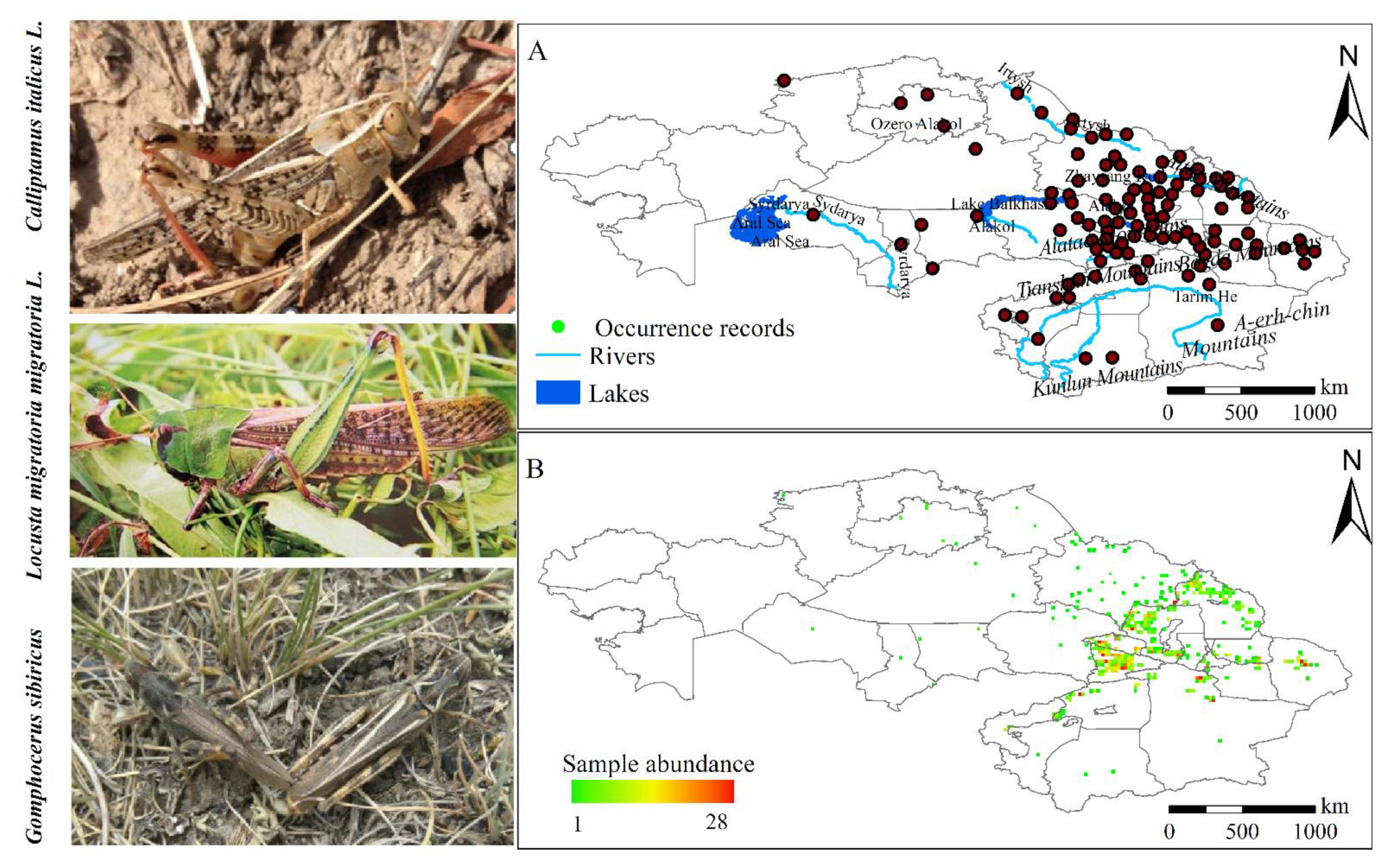
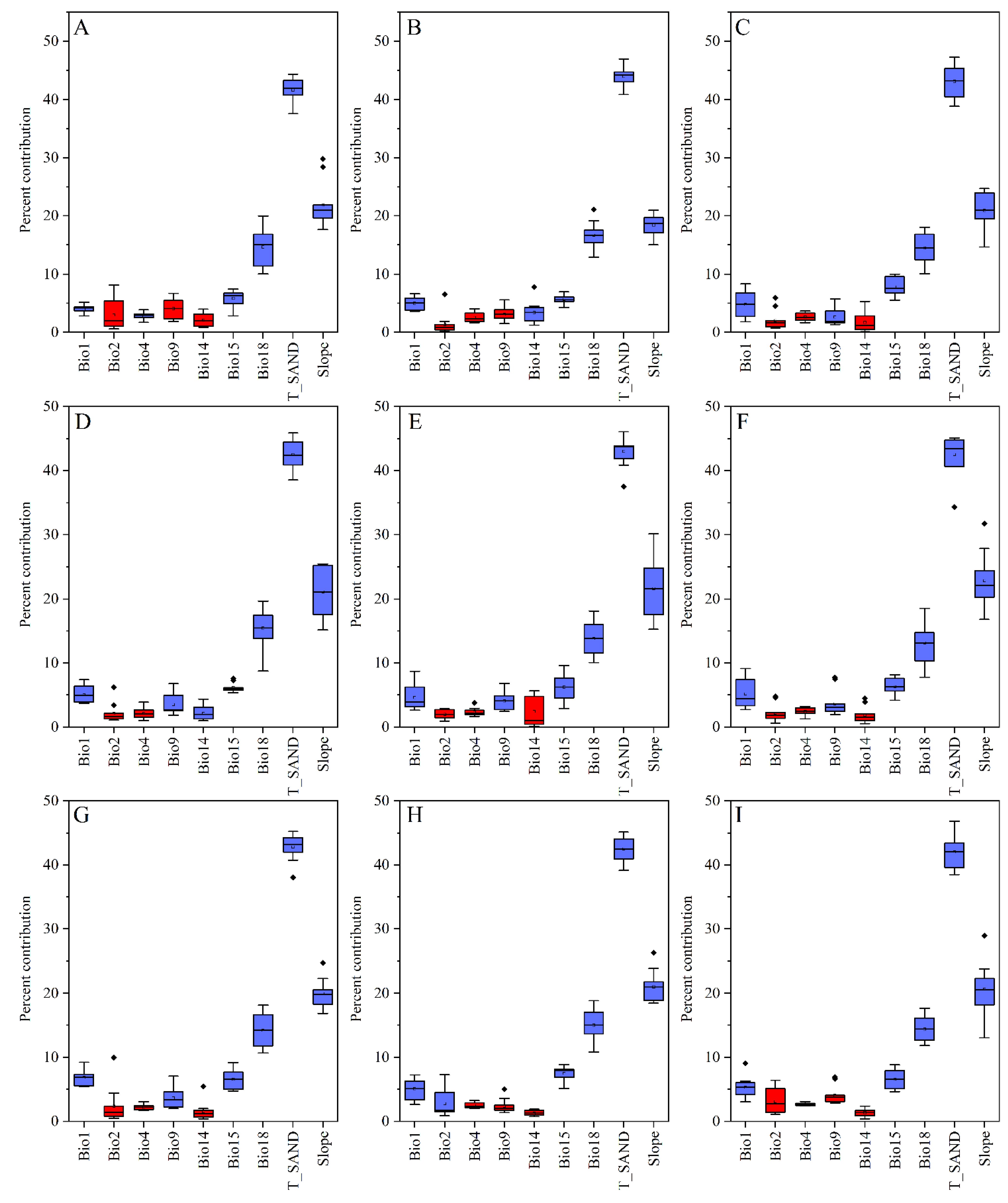
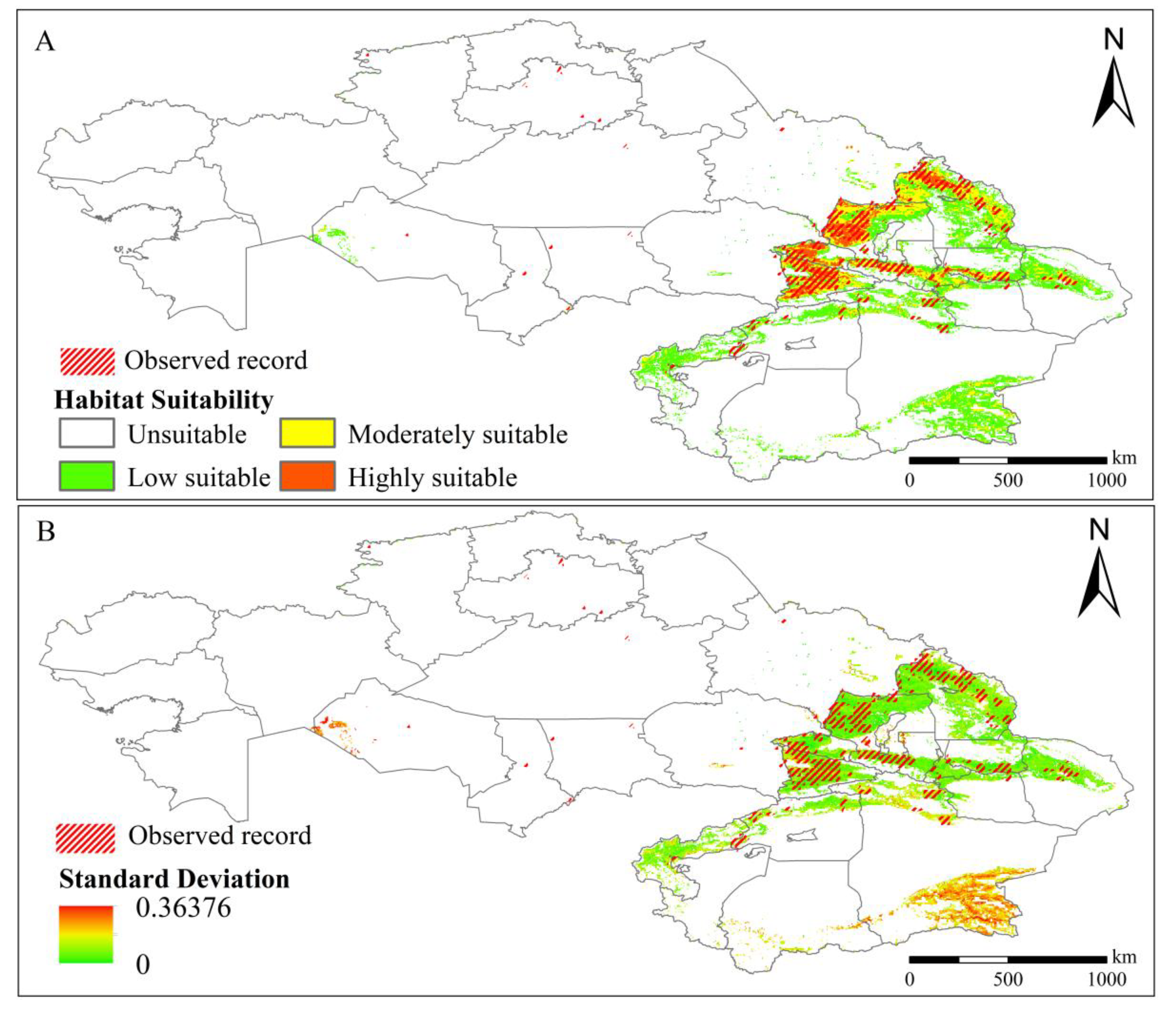
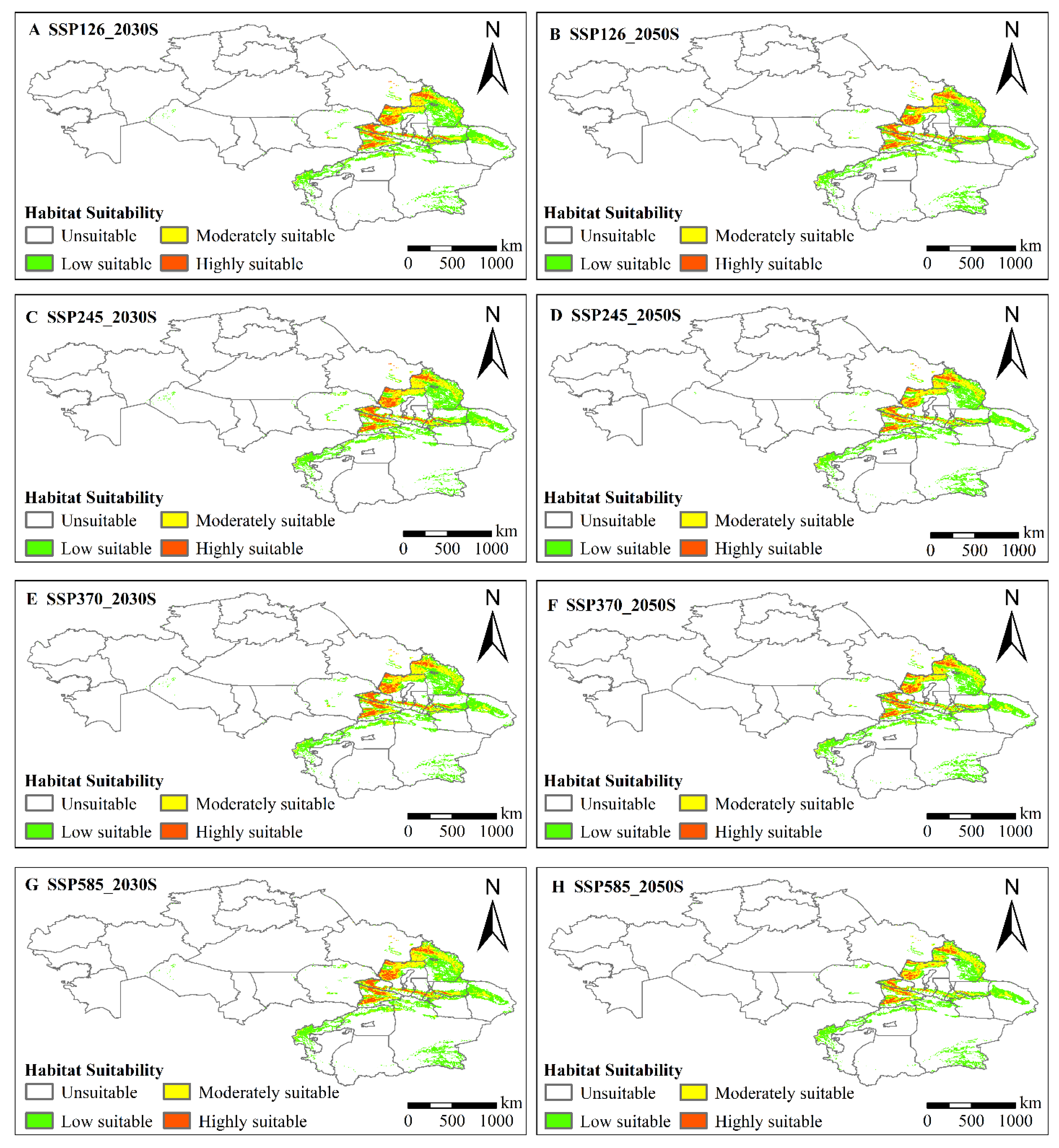

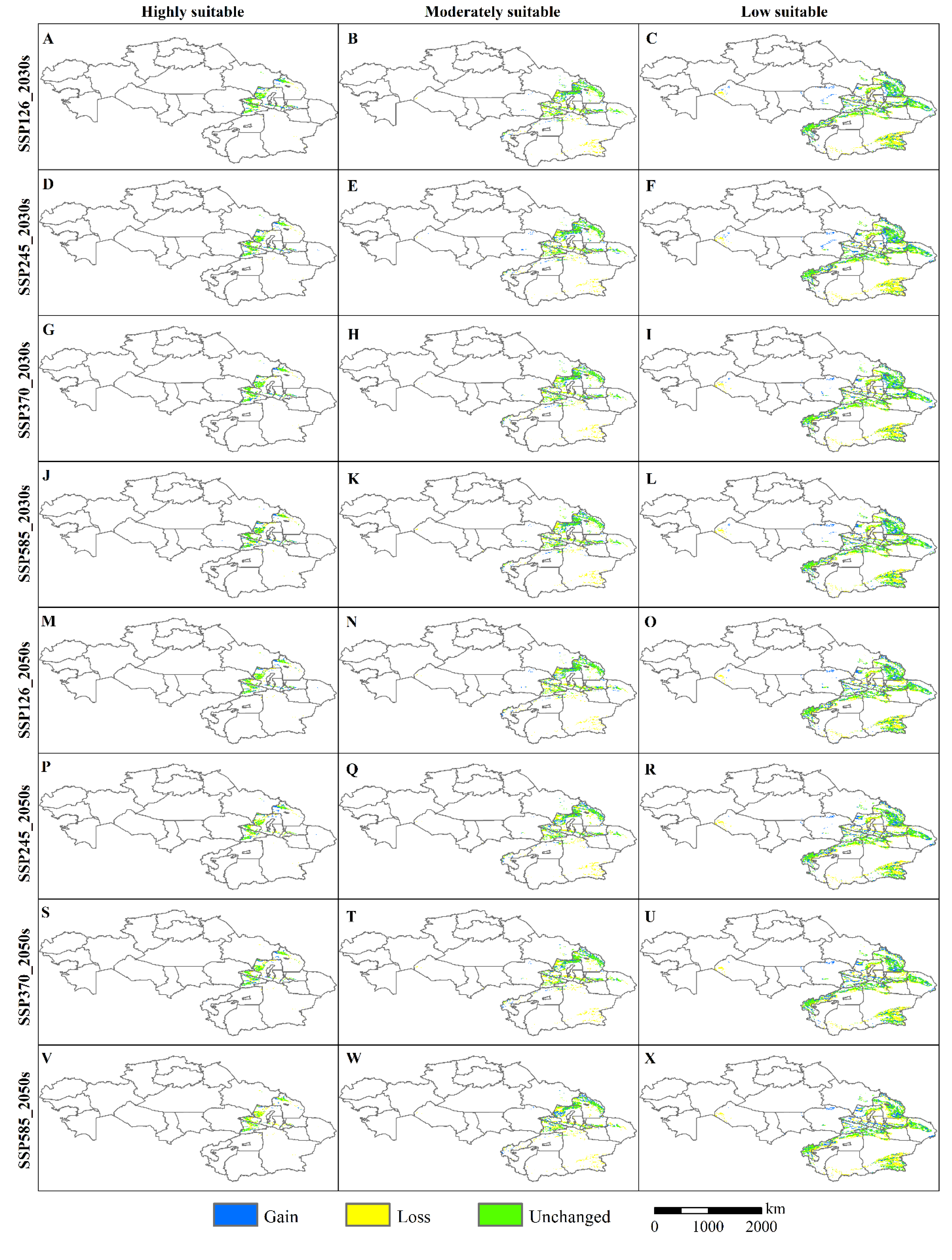
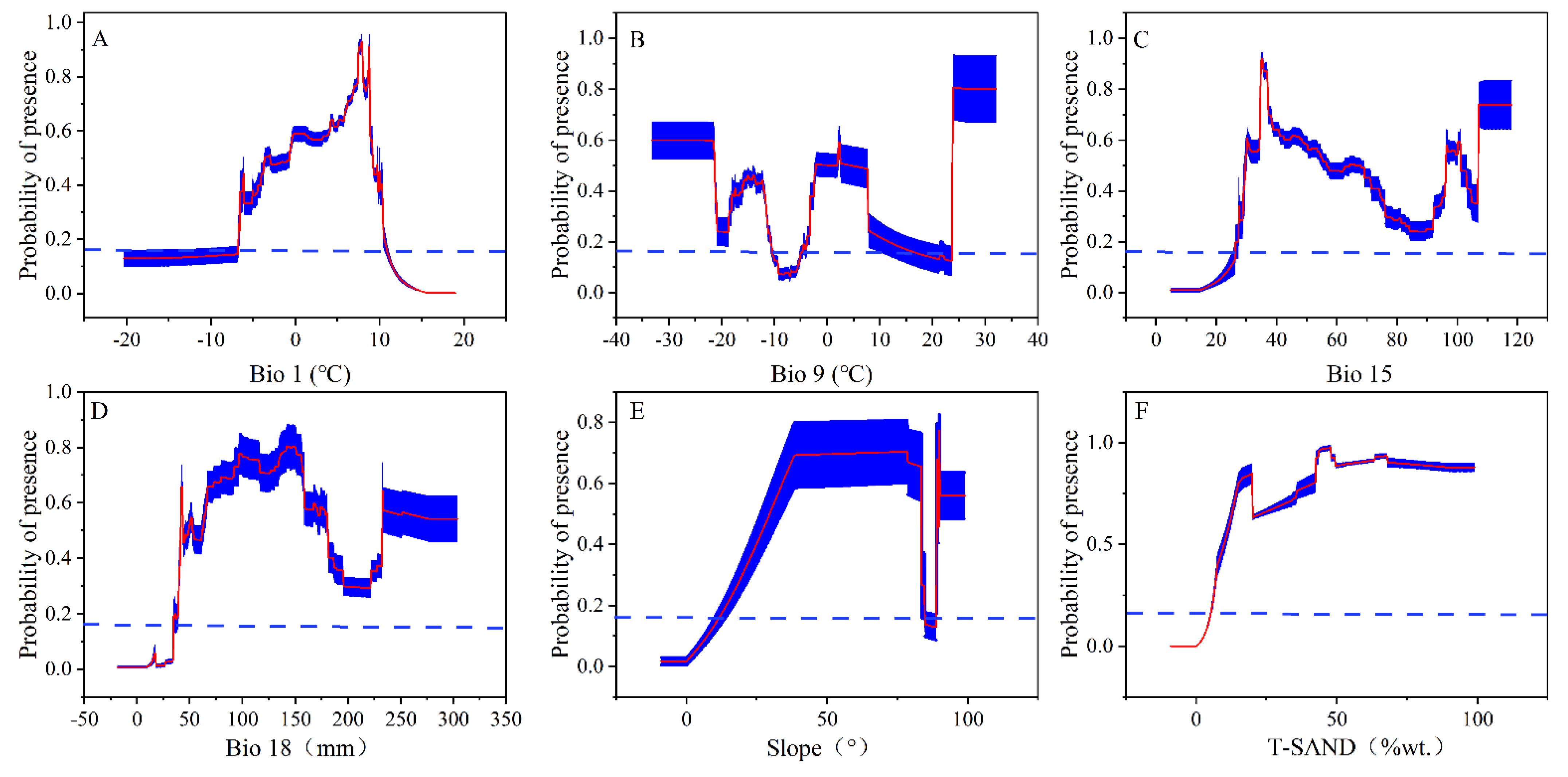

| Variable | Description | VIF |
|---|---|---|
| Bio1 | Annual Mean Temperature (°C) | 3.155 |
| Bio2 | Mean Diurnal Range (mean of monthly (max temp−min temp)) | 1.402 |
| Bio4 | Temperature Seasonality (standard deviation × 100) | 4.956 |
| Bio9 | Mean Temperature of Driest Quarter (°C) | 2.97 |
| Bio14 | Precipitation of Driest Month (mm) | 8.408 |
| Bio15 | Precipitation Seasonality (coefficient of variation) | 7.482 |
| Bio18 | Precipitation of Warmest Quarter (mm) | 8.022 |
| Slope | Slope (°) | 1.074 |
| T-SAND | Topsoil Sand Fraction (%wt.) | 1.137 |
| Scenarios | Time | Low Suitable Area (×105 km2) | Moderately Suitable Area (×105 km2) | Highly Suitable Area (×105 km2) | ||||||
|---|---|---|---|---|---|---|---|---|---|---|
| Gain | Loss | Unchanged | Gain | Loss | Unchanged | Gain | Loss | Unchanged | ||
| SSP126 | 2030s | 0.94 | 1.20 | 1.63 | 0.32 | 0.52 | 0.67 | 0.15 | 0.13 | 0.33 |
| 2050s | 0.92 | 1.22 | 1.61 | 0.31 | 0.56 | 0.63 | 0.15 | 0.15 | 0.32 | |
| SSP245 | 2030s | 0.96 | 1.30 | 1.53 | 0.36 | 0.53 | 0.66 | 0.17 | 0.13 | 0.34 |
| 2050s | 0.96 | 1.28 | 1.55 | 0.35 | 0.58 | 0.61 | 0.12 | 0.20 | 0.26 | |
| SSP370 | 2030s | 0.91 | 1.23 | 1.60 | 0.32 | 0.51 | 0.68 | 0.15 | 0.13 | 0.34 |
| 2050s | 0.93 | 1.31 | 1.51 | 0.31 | 0.58 | 0.61 | 0.12 | 0.17 | 0.30 | |
| SSP585 | 2030s | 0.97 | 1.17 | 1.66 | 0.35 | 0.52 | 0.67 | 0.15 | 0.14 | 0.32 |
| 2050s | 0.94 | 1.41 | 1.41 | 0.35 | 0.52 | 0.67 | 0.08 | 0.24 | 0.22 | |
Publisher’s Note: MDPI stays neutral with regard to jurisdictional claims in published maps and institutional affiliations. |
© 2022 by the authors. Licensee MDPI, Basel, Switzerland. This article is an open access article distributed under the terms and conditions of the Creative Commons Attribution (CC BY) license (https://creativecommons.org/licenses/by/4.0/).
Share and Cite
Wu, R.; Guan, J.-Y.; Wu, J.-G.; Ju, X.-F.; An, Q.-H.; Zheng, J.-H. Predictions Based on Different Climate Change Scenarios: The Habitat of Typical Locust Species Is Shrinking in Kazakhstan and Xinjiang, China. Insects 2022, 13, 942. https://doi.org/10.3390/insects13100942
Wu R, Guan J-Y, Wu J-G, Ju X-F, An Q-H, Zheng J-H. Predictions Based on Different Climate Change Scenarios: The Habitat of Typical Locust Species Is Shrinking in Kazakhstan and Xinjiang, China. Insects. 2022; 13(10):942. https://doi.org/10.3390/insects13100942
Chicago/Turabian StyleWu, Rui, Jing-Yun Guan, Jian-Guo Wu, Xi-Feng Ju, Qing-Hui An, and Jiang-Hua Zheng. 2022. "Predictions Based on Different Climate Change Scenarios: The Habitat of Typical Locust Species Is Shrinking in Kazakhstan and Xinjiang, China" Insects 13, no. 10: 942. https://doi.org/10.3390/insects13100942
APA StyleWu, R., Guan, J.-Y., Wu, J.-G., Ju, X.-F., An, Q.-H., & Zheng, J.-H. (2022). Predictions Based on Different Climate Change Scenarios: The Habitat of Typical Locust Species Is Shrinking in Kazakhstan and Xinjiang, China. Insects, 13(10), 942. https://doi.org/10.3390/insects13100942






